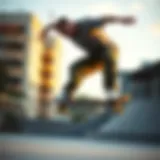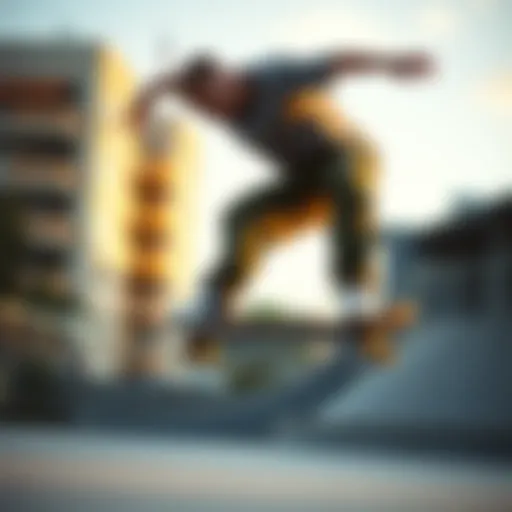Skateboarding Attire: A Complete Guide to Style and Function

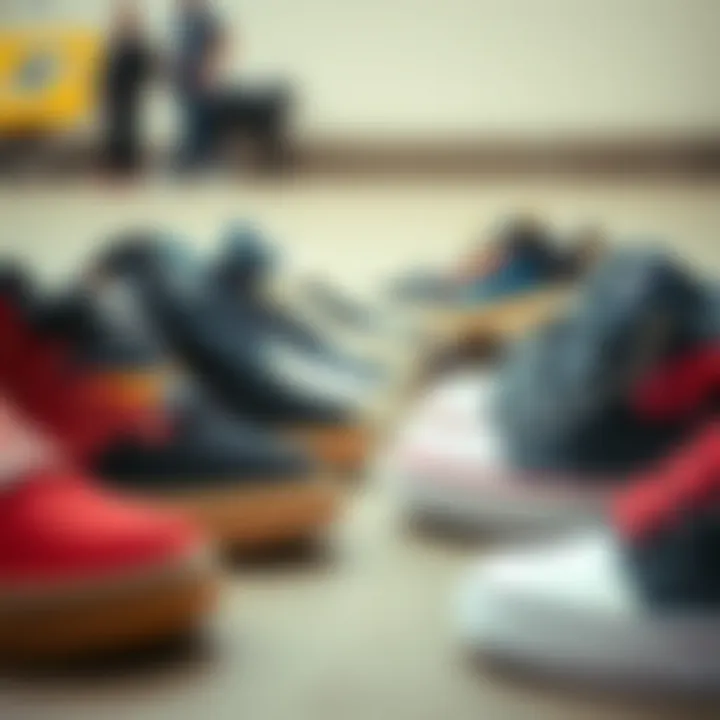
Intro
Skateboarding is more than a mere pastime; it's a rich tapestry woven with personal expression, community ties, and an ever-evolving culture. From the moment a skateboarder steps onto the board, there's a profound relationship formed not just with the equipment, but also with the attire that accompanies this activity. The right clothing and gear can enhance not only the performance but also one’s sense of individuality.
In this guide, we will navigate through the various layers of skateboarding attire. First, we'll explore the techniques that form the backbone of skateboarding, from fundamental skills to advanced tricks. Following this, we will delve into the essential gear and equipment that ensure safety and comfort while also allowing for stylistic flair. Throughout this discourse, we will also spotlight the convergence of functionality, sustainability, and personal expression that characterizes modern skatewear.
Given the unique demands of skating, the right apparel is not only about visual appeal but should also account for practical aspects. After all, a well-fitted pair of shoes or the right type of pads can mean the difference between a successful trick and a nasty fall. Hence, understanding how to balance style and performance is crucial for both newcomers and seasoned skaters alike.
By the end of this exploration, you’ll be equipped with knowledge on how to choose the best skateboarding attire tailored for various purposes—whether you’re hitting the local park, attempting a new stunt, or simply hanging out with fellow skate enthusiasts. So, let’s kick off this journey!
Understanding Skateboarding Attire
Skateboarding attire is not just about looking good at the park or on the streets; it carries deep-rooted significance within the culture and community that encompasses skateboarding. To understand skateboarding attire is to grasp a piece of the very identity that many skateboarders hold dear. When someone steps on a board, their choice of clothing communicates a multitude of messages: from personal style to a sense of belonging to the wider skate culture.
The Role of Attire in Skateboarding Culture
The way skateboarders dress is a reflection of their lifestyles and beliefs. Brands like Supreme and Thrasher resonate with riders far beyond their product lines. These brands offer more than just clothes; they symbolize unity, individuality, and rebellion against the mainstream. Wearing specific attire can be a badge of honor, marking one’s participation in this subculture, while also showcasing personal taste.
Additionally, attire serves practical purposes. For example, loose-fitting clothes allow for mobility, which is crucial when executing tricks. This functionality doesn’t come at the expense of style. The balance of form and function is key; skateboarders aim to look sharp while being able to move freely. Often someone dressed in baggy pants and a graphic tee can nail a trick more comfortably than someone in tight or restrictive garments.
Moreover, attire can influence the way skateboarders perceive themselves and how others see them. Skateboarding fashion often embraces a laid-back aesthetic, allowing individuals to express their uniqueness while also connecting them with their peers. In a world increasingly defined by conformity, the choice of attire in skateboarding stands as a form of self-expression, allowing for individuality within the collective.
Historical Context of Skateboarding Clothing
To truly appreciate skateboarding attire, one must look back at its evolution. The late 1950s and early 1960s saw the emergence of skate culture, driven by surfers seeking an alternative when the waves were flat. Initially, attire was dictated more by necessity than style, with riders donning whatever was handy or comfortable—often casual wear typical of beach culture.
As the sport grew more popular, so did the distinct fashion that accompanied it. The 1980s marked a turning point, as brands began to identify the commercial potential within punk and street culture. Skateboarders gravitated towards vibrant colors, oversized silhouettes, and eclectic patterns that showcased their rebellion against societal norms. Companies like Santa Cruz and Powell Peralta played pivotal roles, offering not just boards but also fashion-forward merchandise that appealed to their audience.
In the 1990s, with skateboarding gaining more mainstream acceptance, there was a push towards more specialized attire. The focus shifted to functionality—materials were designed to enhance performance while allowing skaters to showcase their signature styles. Today, skateboarding attire reflects a myriad of influences—from streetwear to high fashion—demonstrating how far the culture has come since those early days.
To sum it up, skateboarding attire encapsulates much more than mere clothing. It is steeped in history, serves practical purposes, and acts as a vessel for personal and collective identity within the skater community. Understanding this attire opens up dialogues about culture, history, and how individuals express themselves in a world often eager to pigeonhole them.
Essential Footwear for Skateboarding
Footwear serves as the foundation of every skateboarding outfit, impacting not just individual style but also performance. Ideal skate shoes are integral to comfort, grip, and, most importantly, the safety of the rider. When it comes to cruising down ramps or performing tricks, the right pair of shoes can make or break the experience, offering support and stability that could prevent injuries. Beyond just aesthetics, skate shoes are marrying form and function to ensure that skateboarders can express their unique tastes while engaging in their sport safely.
Characteristics of Ideal Skate Shoes
When selecting footwear for skateboarding, several key characteristics should be looked at. Grip is essential; skate shoes typically have flat rubber soles to enhance traction on the board. This quality prevents slips when landing tricks or during sharp turns.
Another crucial element is durability. Skate shoes endure wear and tear, especially at the toe and sides. Reinforced areas like ollie pads help resist fraying, ensuring that shoes last through countless sessions at the skatepark.
Consider also the padding and support these shoes provide. Adequate ankle and arch support are vital to minimizing strain while performing complex moves. A snug fit, without being overly tight, is key to preventing blisters and discomfort, allowing a rider to focus solely on skating, not on sore feet.
"The right skate shoes are not merely a fashion statement; they are a skateboarder's best ally on the board."
Popular Skate Shoe Brands
Several reputable brands have made their mark in the skateboarding community, recognized for both their quality and innovation. Vans remains a strong favorite, known for its classic designs and excellent grip. Nike SB has also gained a loyal following, blending high-performance technology with stylish aesthetics. Meanwhile, Adidas Skateboarding merges street style with practicality, offering a wide range of options for every skater.
Other noteworthy mentions include DC Shoes, renowned for their comfort and bold style, and Emerica, which caters especially to skateboarders who prioritize durability. each of these brands puts their stamp on skate culture, pushing the boundaries of design while ensuring that rider performance is at the forefront.
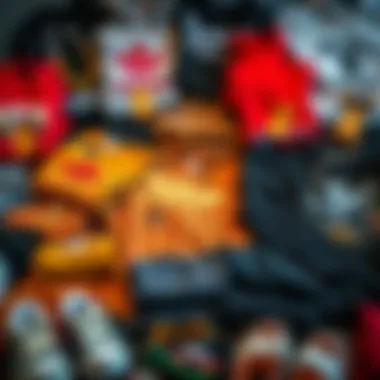
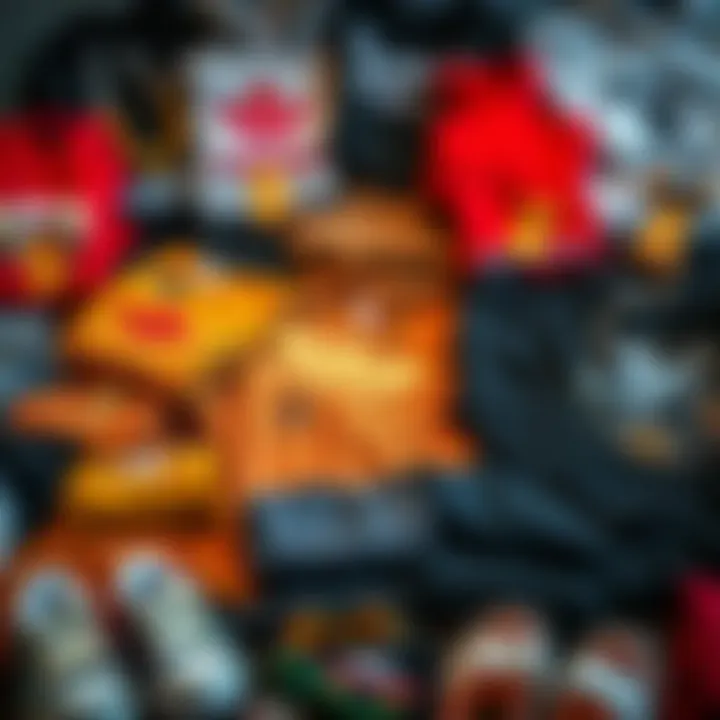
Choosing the Right Size and Fit
Selecting the right size for skate shoes is more than just picking the number that fits. It’s a delicate balance of overall comfort and functional support. First off, getting foot measurements is a step often overlooked; trying on shoes at the end of the day is recommended since feet expand throughout the day.
When trying on shoes, observe the fit around the toes and heel. Ideally, there should be a thumb's width of space at the toe box, while the heel should stay in place to avoid blisters or any movement that could lead to a fall. Lacing also plays an important role. Tightly laced shoes can provide better stability but may require loosening during extended skating sessions for breathability.
Lastly, don’t hesitate to seek advice from fellow skaters or professionals at local skate shops. They can offer helpful tips on brands and style preferences, ultimately aiding in a better purchase decision.
Choosing the right footwear can significantly enhance the skateboarding experience, blending safety with style while highlighting the individuality of every skater.
For more tips on skateboarding safety and gear, you can refer to popular skateboarding forums on Reddit or look at the latest gear reviews on sites like Skate Warehouse and Tactics.
Skateboarding Apparel: A Style Perspective
When it comes to skateboarding, the attire isn't just about looking good; it's about blending style with functionality. The essence of skateboarding apparel lies in its ability to embody the culture while providing comfort and freedom of movement. Understanding this perspective enables both novices and veterans to make informed choices in their skateboarding journey.
Types of Skateboarding Clothing
Shirts and Hoodies
Shirts and hoodies are staples in any skateboarder's wardrobe. What really sets these pieces apart is their fit and breathability. A quality hoodie, particularly those made from cotton blends, offers comfort during chilly sessions while still showing off some personality through graphics or unique designs. They're versatile too - perfect for layering or wearing solo.
A key aspect of hoodies is their convenience; they can easily be tossed on or off, accommodating changing weather. However, one may argue that some overly loose designs might catch on a skateboard, creating little hiccups in movements, but overall the depth of styles makes them a popular choice. Brands like Supreme or Thrasher often showcase not only a streetwear vibe but also an unspoken sense of rebellion that resonates with skaters.
Pants and Shorts
Let's not forget about pants and shorts, pivotal elements in skateboarding attire. Comfort and mobility are paramount, and many skateboarders prefer cargo shorts or loose-fitting pants for that very reason. The appeal of these features lies in their ability to allow a full range of motion while performing tricks. The fabric choice is crucial; denim with a bit of stretch can truly make a difference.
Some might lean towards joggers for a trendier approach. These often feature elastic cuffs, which can prevent pant legs from dragging under the board. However, a downside comes with the elegant fit, as joggers may lack the durability found in traditional skate pants, made specifically to withstand wear and tear.
Accessories
Accessories hold a special place in the hearts of skateboarders. From caps to beanies, these items are not just stylish; they serve practical purposes as well. A fitted cap can keep the sun out of your eyes, while a beanie can ward off that biting chill. Additionally, wristbands or reusable water bottles can enhance the experience by adding a personalized touch to one’s skating lifestyle.
What’s more, unique accessories can offer a snapshot into an individual's skating style and preferences. However, some accessories can get in the way. For instance, oversized accessories could impede movement or become dislodged during a trick. Balancing aesthetics with practicality is vital when selecting these items.
Material Considerations for Performance
When discussing skateboarding apparel, the choice of material is just as critical as the style. Fabrics like polyester blends or cotton-poly mixes provide optimal stretch and durability. Breathability should also be considered to combat sweat during long sessions. Some newer materials incorporate moisture-wicking properties, offering an edge in performance.
In addition, there’s a rising trend toward sustainable materials in the skateboard community. Elements like recycled polyester, derived from discarded plastics, are gaining traction and are worth exploring for environmentally conscious skaters.
Ultimately, selecting apparel that mirrors one’s personal style while meeting the demands of the sport can turn a simple skateboarder’s outfit into a statement of identity.
In summation, skateboarding apparel is not merely functional; it is intertwined with the culture, offering a canvas for self-expression and identity within the community.
Protective Gear: Safety First
When it comes to skateboarding, safety is paramount. Protective gear serves not merely as an accessory but as a lifeline, essential for minimizing injury during skate sessions. The thrill of skating is matched only by the risk of falls and accidents, making appropriate gear a fundamental aspect of the sport. Wearing protective equipment can significantly reduce the severity of injuries, allowing individuals to enjoy their passion for skating while minimizing risks.
Importance of Protective Gear
The significance of protective gear cannot be overstated. Skateboarding is an adventure, and adventures come with their share of bumps and bruises. Protective gear acts as your safeguard, helping skaters maintain confidence while tackling new tricks or attempting high-speed descents. This gear gives both beginners and seasoned pros peace of mind, allowing them to express themselves through their skating without the constant worry of injury. In short, it promotes not just safety but the overall enjoyment of the sport.

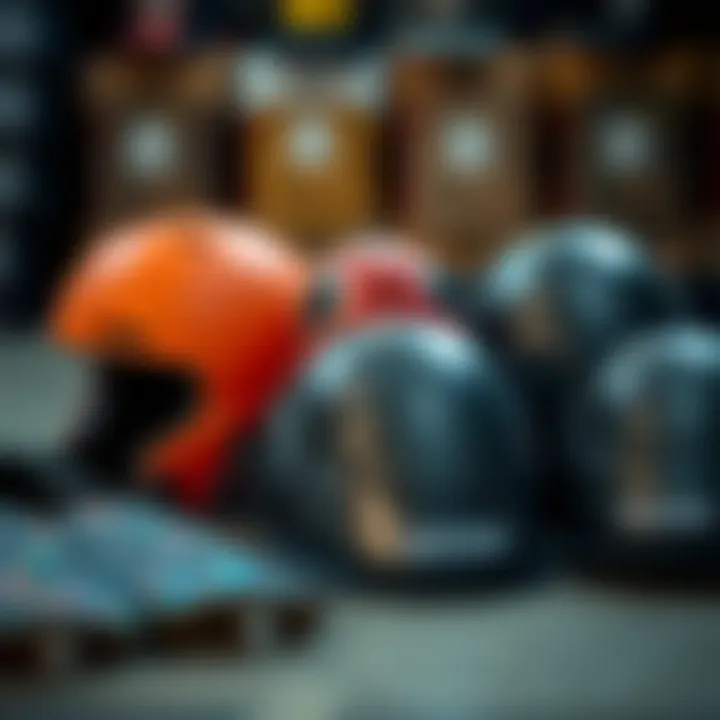
Types of Protective Equipment
Helmets
Helmets are the cornerstone of skateboard protection. They form the first line of defense against head injuries, which can be life-altering. A high-quality helmet is designed to absorb impact, dissipating the force across a wider area. Not only does it protect against falls, but a well-fitted helmet boosts a skater's confidence, encouraging them to take on new challenges. Many brands offer helmets with adjustable straps and removable liners for customization, a feature that enhances comfort and fit.
Elbow Pads
Elbow pads are another vital part of protective gear. Their main role is to cushion the elbows during falls, reducing the risk of fractures or bruising. These pads typically come with hard caps that deflect impacts while allowing freedom of movement. A striking point is their versatility; they can also be used off the board, making them a popular choice among riders who engage in other extreme sports. While some might find them bulky, advancements in design have led to slimmer, more ergonomic models that offer great protection without sacrificing comfort.
Knee Pads
Knee pads play an essential role in shielding the knees, a common impact zone when skateboarders take a tumble. Quality knee pads provide superior cushioning and stability, which can be critical for those trying out advanced tricks. What many may not realize is that knee pads can enhance performance by allowing skaters to be more fearless, knowing they have protection in place. However, when selecting knee pads, it is important to find ones that are snug yet allow for unrestricted movement.
Wrist Guards
Wrist guards are specifically designed to protect one of the most vulnerable parts of the body during a fall. Skaters often instinctively use their hands to break a fall, which can lead to sprained wrists or even fractures. These guards brace the wrist while still allowing for some flexibility, making them an almost necessary accessory for beginners. The ease of slipping them on and off encourages habitual use, which is crucial for injury prevention. Skaters must choose guards that fit well; a proper fit ensures maximum protection and comfort during rides.
"Protective gear is not just an accessory; it's a necessary part of skateboarding culture, intertwining safety with style." - Anonymous skater
Fashion Trends in Skateboarding Attire
Fashion trends in skateboarding attire do more than just set the style; they reveal the evolving landscape of skate culture itself. Over the years, skateboarding has morphed from a subculture into a mainstream phenomenon, and with this transformation, the attire has grown into a canvas for self-expression and identity. Skateboarding attire serves not only aesthetic purposes but also functional needs, catering to the necessity of comfort and safety on the board.
Certainly, having the right gear can significantly influence a rider's performance. However, the importance of fashion trends extends beyond just gear functionality. Today, skateboarders are not only thinkers and bred champions. They become icons, displaying trends that resonate with their personal narratives and societal messages.
The current trends echo a fusion of comfort, practicality, and personal style, often borrowing elements from other fashion realms, which gives the attire a distinctive twist. Generally, you’ll find that trends emphasize eco-friendliness, with brands opting for sustainable materials, which aligns with the growing awareness regarding environmental responsibility in the skate community.
Influence of Streetwear on Skate Fashion
Streetwear has undeniably made a significant imprint on skate fashion, turning skate attire into a cultural hybrid that draws from urban influences. From oversized graphic t-shirts and relaxed-fit jeans to stylish hoodies that often bear bold logos or slogans, streetwear breathes new life into traditional skate basics.
This trend doesn’t just cater to aesthetics; it speaks to a sense of belonging and identity within urban landscapes. Skateboarders who embrace streetwear often find themselves part of a larger cultural dialogue, as these styles echo the voices of city life and youthful rebellion.
"Streetwear isn't just fashion; it's a statement of who you are as a rider. You can express your beliefs and stand for something."
Some core components captured from this trend include:
- Comfort: Loose and breathable materials are preferred, allowing ease of movement.
- Visual Impact: Graphics and bold colors reflect individuality, often drawing attention in crowded urban settings.
- Cultural Fusion: A mix of influences from hip-hop, skate, and even high fashion stimulates creativity and diversity.
Celebrity Endorsements and Collaborations
In the world of skateboarding, celebrity endorsements have become a potent force in shaping fashion trends. When a famous skateboarder like Nyjah Huston or a pop culture icon like Travis Scott teams up with a brand, it sends ripples throughout the skate community. Such collaborations can elevate the visibility of particular styles and introduce fresh ideas into skate fashion, pushing the envelope of what's possible.
These partnerships often yield limited edition pieces, creating a buzz not only within the skateboarding circles but also reaching the broader public. The collaboration between Nike SB and renowned artists or stylish skaters brings authenticity and excitement, merging skate culture with mainstream appeal.
Important aspects of these endorsements include:
- Market Reach: Celebrity endorsements often draw in fans from outside the skateboarding realm, expanding the market.
- Innovation: Collaborations frequently lead to innovative designs and technologies that enhance performance.
- Cultural Relevance: They help keep skateboarding relevant in the fast-changing fashion landscape, ensuring that it is in step with the latest trends and societal movements.
In closing, fashion trends in skateboarding attire reflect a continuous cycle of influences that encompass cultural, social, and artistic domains. With each passing year, the dialogue between performance, identity, and style grows richer, making skate wear an essential aspect of the sport.
Sustainable Practices in Skateboarding Attire


Sustainability is becoming an essential topic in many industries, and skateboarding is no exception. As environmental concerns mount and awareness grows about the impact of consumer choices, skateboarders and brands alike are taking steps to incorporate sustainable practices in their attire. This section sheds light on why these practices matter in the skateboard community and how they can shape the future of the sport.
One of the most significant aspects of sustainable practices is the potential for reducing waste. Skateboarding, with its culture that promotes individuality and self-expression, can be a driver for broader changes in consumer behavior. By adopting eco-friendly materials and supporting brands committed to sustainability, skateboarders can align their passion for the sport with the principles of environmental stewardship.
Eco-Friendly Materials and Brands
When discussing eco-friendly materials, it's critical to consider what alternatives are available to traditional fabrics and plastics. Many brands are now focusing on using organic cotton, recycled polyester, and hemp. For instance, companies such as Element and Patagonia are pioneering the use of bio-based materials, which significantly reduces the carbon footprint associated with production.
- Organic Cotton: Unlike conventional cotton that requires pesticides and fertilizers, organic cotton is grown without such harmful chemicals. This means cleaner water and healthier farming practices.
- Recycled Polyester: Brands are increasingly incorporating fibers from used plastics, creating a closed-loop system that minimizes waste and pollution.
- Hemp: This hardy plant grows quickly and requires little water compared to cotton. Its fibers are durable, making it an ideal choice for skate clothes.
These materials not only help reduce environmental impact but also stand the test of time, ensuring that your gear lasts longer on the skatepark.
The Rise of Second-Hand and Upcycled Clothing
In a world dominated by fast fashion, the rise of second-hand clothing has emerged as a robust counter-narrative. Skateboarding culture has always emphasized creativity and personal style, and thrifting or upcycling clothing allows skateboarders to express themselves unique.
Collectively, these practices contribute to a more sustainable approach to fashion. Wearing second-hand clothing helps reduce demand for new products, which in turn lessens the strain on natural resources.
"What goes around comes around. Skateboarding thrives on the unique and the one-off!"
Upcycling, on the other hand, transforms old garments into something new and exciting. This can be as simple as cutting off the sleeves of a hooded sweatshirt to create a sleeveless top or more complex designs that incorporate patches and various fabrics. In essence, upcycling brings a renewed life to forgotten pieces, making them fashionable once more.
The community aspect can’t be overlooked either — local shops and online platforms like Depop or eBay facilitate the buying and selling of second-hand gear. This not only keeps skateboarding affordable but also creates a circular economy where skateboarders support each other,
Cultural Significance of Skateboarding Attire
Skateboarding attire goes beyond mere functionality; it serves as a potent symbol of identity and community within the skate culture. The clothes skateboarders choose are not just about looking cool on the board, but they also express individual styles, beliefs, and affiliations. From the baggy pants that were once the hallmark of the street skate style to the sleek, form-fitting gear of modern skateboarders, attire constantly evolves, mirroring the cultural shifts and social attitudes of the time.
Attire as a Reflection of Identity
The way skateboarders dress is often deeply intertwined with their identities. Clothing can communicate subtle, yet powerful messages about who a person is, where they come from, and their outlook on life. For instance, the use of vintage brands or thrifted items may point to a skater's appreciation of authenticity and a sustainable lifestyle. In contrast, high-end collaborations often highlight a connection to mainstream fashion.
Moreover, the selection of colors, patterns, and even logos can tell a story about one’s local scene or personal experiences. For many, skate parks become a canvas for self-expression, with each skateboarder showcasing their unique style through their choice of attire. It’s not rare to see a skater donning vibrant prints or DIY patches, each telling a piece of their narrative. This personal touch helps build a colorful tapestry where diversity thrives, and each individual’s story adds to the overall culture.
"Skateboarding attire is not just about looking the part; it’s a badge of belonging in a unique, global community that values self-expression and authenticity."
Regional Variations in Skate Style
Skateboarding attire also reflects regional variations that are influenced by local cultures, climates, and urban environments. For example, skateboards in California might embrace a sun-soaked, laid-back style, often opting for lighter fabrics and vibrant colors suitable for a warm climate. Conversely, in the cooler regions, such as the Pacific Northwest, layering becomes essential, leading to a penchant for oversized hoodies and durable outerwear that can withstand drizzly conditions.
Additionally, cultural and socioeconomic factors heavily inform these regional styles. In places where skateboarding is associated with street art or punk subcultures, one might notice an inclination towards edgier, more rebellious fashion statements. In other areas, skate attire may blend more fluidly with mainstream trends, reflecting a more polished and stylish aesthetic. The geographic distinctions create an interesting mosaic of styles, with each area carving out its unique territory within the global skateboarding community.
The Future of Skateboarding Attire
As skateboarding continues to evolve, so does its attire. The discussions around the future of skateboarding clothing and gear are more than just trend forecasting; they encapsulate the intersection of functionality, style, and technology. For skateboarders, parents, and retailers alike, understanding these shifts can lead to better choices and innovations that can significantly impact the skateboarding community. The essence of skate attire is rooted in personal expression, yet as the industry grows, it embraces new advancements and sustainable practices that shape what riders wear and how they perform.
Innovations and Technology in Skate Gear
The landscape of skateboarding gear is rapidly changing due to technological advancements. Companies have started to integrate smart materials into their designs. For instance, moisture-wicking fabrics are now standard in many skate shirts, which help maintain comfort during intense sessions.
- Responsive Materials: Innovations like self-healing materials make skate shoes more durable. Microfiber and synthetic options provide additional protection and support, adapting better to the wear and tear of rough surfaces.
- Impact Resistance: Skateboards and protective wear are now often engineered with materials that absorb shock more effectively. High-density foam and gel inserts can reduce injuries by absorbing the impact from falls.
- Sustainable Approaches: The call for greener options led brands like Vans and Nike SB to develop lines that use recycled materials, lowering environmental footprints. Skate culture's youth-driven trend towards sustainability seems to be more than just a passing phase; it's an evolving standard.
"Innovation in skate gear is not merely about adapting to trends. It also shows a commitment to functionality and a positive environmental impact, making the sport inclusive and responsible."
Predicted Trends for Upcoming Years
Looking ahead, various trends are set to redefine skateboarding attire:
- Personalization: As customization becomes more accessible, skate shoes and apparel will allow for personal designs. Brands might introduce platforms where riders can choose colors, patterns, and even materials to enhance their gear.
- Smart Technology: Tech integration might not stop at performance materials. The future could bring hybrid devices such as smart helmets tracking impacts or even shoes with built-in sensors. These innovations could be game-changers for safety and performance monitoring.
- Inclusivity in Design: Expect to see clothing that caters to diverse body types and styles. As the realm of skateboarding moves towards inclusivity, brands are likely to capture broader audiences, promoting styles that resonate with various identities and cultures.
In sum, the future of skateboarding attire is not only about keeping up with trends but also embracing the varied dimensions of technology, sustainability, and personal expression. As skateboarders become more conscious of their gear's impact on their performance and the world, the industry can expect a continued push towards innovation that reflects these values.




